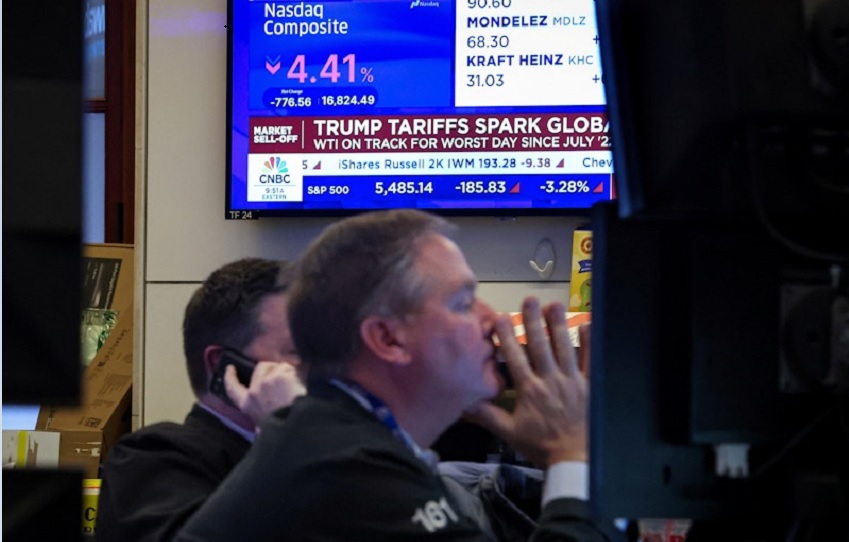
The New York Stock Exchange registered a historical fall in the reference rates of Wall Street this Thursday, the largest in a day since the beginning of the Covid-19 pandemic in March 2020, after the announcements of the president of the United States, Donald Trump, of a generalized rise in tariffs to the imports of products of 10% or more. The response of “the markets” was the flight of risk assets, given fears of climbing the commercial war with China and the European Union and that the world economy enters recession.
In this context, the index Dow Jones (industrial sectors) lowered a 4%; he S&P 500 Index (the largest companies) lost 4.8% and Nasdaq composite (financial and technological) 6% collapsed. It is estimated that the S&P 500 lost 2.4 billion dollars In market value, the largest amount from the Covid-19 days.
Las technological actions In fact they are the ones that suffered the greatest falls after promoting Wall Street to historical maximums in recent years. Apple It was one of the most affected, with a 10% decrease given the high rate imposed on China, the basis of much of the manufacture of the mega company. They also broke the actions of Nvidia (-7%) y Tesla (-5.6%), descending the latter what he won on Wednesday, given the appearance of reports on executive director Elon Musk, who could resign his position in the Trump government.
In turn, the titles of the great sellers of imported products are among the most affected. Five Below (-26.1%), Dollar Tree (-12%) and GAP (-20%), suffered percentage losses of two digits. The retail sector was also seriously impacted, with Nike (-13%) and Walmart (-2,8) collapsing after the imposition of tariffs on important production centers, such as Vietnam, Indonesia and China.
Trump’s announcement: an unprecedented measure
Donald Trump announced generalized tariffs on Wednesday and A rise to 195 countriesan unprecedented measure. Base implies an additional tax of 10% to all significantly higher imports and rates to countries with which it faces a higher commercial deficit.
Just one month after applying 10% tariffs to China and 25% to Mexico and Canada, the new regulations
imposes additional import rights that reach for example Cambodia (49%), Vietnam (46%), Bangladesh (37%), China (34%) and the European Union (20%).
China faces an additional 34% tariffwhich adds to the rights of 20% already in force. The European Union, Japan and Other countries will see tariffs that will range between 20% and 49%. General tariffs come into force on April 5, and specific increases per country begin on April 9. In the case of Argentina It implies an additional 10% increase.
To define those additional tariffs, the Trump administration simply divided the bilateral trade deficit by imports; and applied half of that percentage as a tariff.

Trump’s argument is that an imposition of higher import tariffs will cause companies to be more competitive to produce in the United States, which would stimulate employment and growth.
This approach is strongly questioned, by different sectors both democrats and republicans and even international organizations. Especially, because the rest of the countries will impose, affecting world trade and economy, in a framework of greater geopolitical conflicts. For working majorities and peoples of the world this most convulsed scenario can only bring greater catastrophes.
Trump also justified tariffs alleging unfair commercial practices and exchange manipulation, stating that these measures would revitalize US industries and reduce national debt.
Trump’s tariff measures are a response to decades of relocation of production to countries with cheaper labor. This phenomenon left entire sectors of the American working class without employment.
The world reaction and the IMF statement
The first reactions were expected. On the one hand, China promised reprisals, like the European Union, which faces a 20%tariff. The Prime Minister of Canada described the situation as a “tragedy” and announced countermeasures before the fall of the country’s stock market. The French president, Macron, said he is pressing EU countries to stop investing in the United States.
For their part, South Korea, Mexico, India and several other commercial partners announced that they would wait for now while looking for concessions before specific tariffs enter into force on April 9.
He International Monetary Fund (IMF) He also entered the scene. This Thursday, the IMF managing director, Kristalina Georgieva, declared that “we are still evaluating the macroeconomic implications of the tariff measures announced, but clearly represent a significant risk for global perspectives in a moment of slow growth. It is important to avoid measures that may further harm the world economy. We urge the United States and its business partners to work constructively to resolve commercial tensions and reduce uncertainty. “
And he added that “we will share the results of our evaluation in perspectives of the world economy, which will be published during the FMI spring meetings and the World Bank at the end of this month.”
The consequences on the global economy
The tariff policy and uncertainty about its consequences began affecting financial markets first and will impact global trade. He oil price Brent already showed a collapse of 6.7% this Thursday, “reaching levels close to its minimum post-pandemic,” analyzes the consultant Epyca.
The World Trade Organization (WTO) stated that “the recent announcements will have substantial implications for world trade and the prospects for economic growth. Although the situation quickly evolves, our initial estimates suggest that these measures, added to those introduced since the beginning of the year, They could cause a general contraction of around 1% in the volume of world trade Dand merchandise this year. “That represents” a downward review of almost four percentage points With respect to the previous projections, “said the WTO.
Swiss Bank UBS estimates that, if these tariffs are maintained, The United States real GDP could decrease between 1.5 and 2 percentage points by 2025while inflation could approach 5%. This scenario “has the potential to worsen considerably the combination of growth and inflation in the US and the world economy next year.”
“The immediate economic consequences will be a contraction of domestic consumption, a lower private investment and greater inflation (+1.5 percentage points). From Epyca we project that the growth of the US GDP in 2025 will be less than 1%,” said the consultant.
Trump’s announcement is another expression of Trump’s new attempt to revitalize the imperial leadership of the United States that comes in decline, generating a greater systemic chaos. As Esteban Mercatante points out, “the only way that resolutions to this mess are not reactionary for the masses, is that a revolutionary exit is imposed that ends the domain of imperialist capitalism. It is essential to strengthen the consistent labor internationalism to build this alternative.”
Source: www.laizquierdadiario.com

